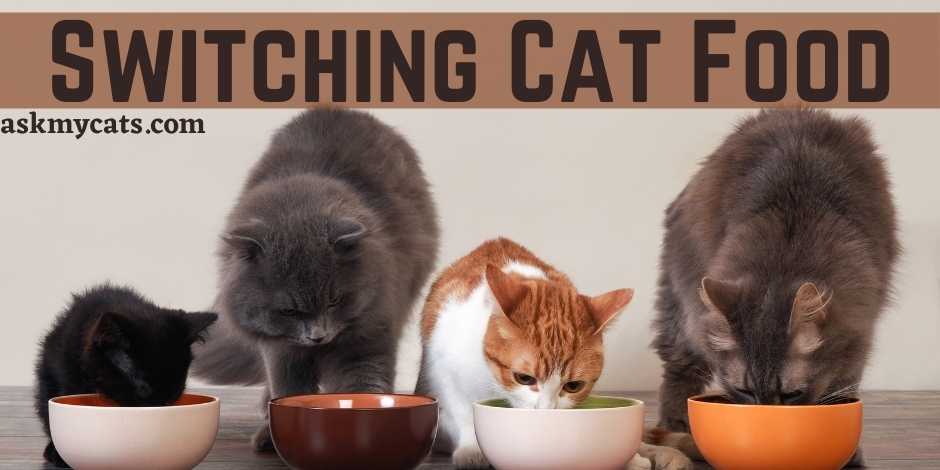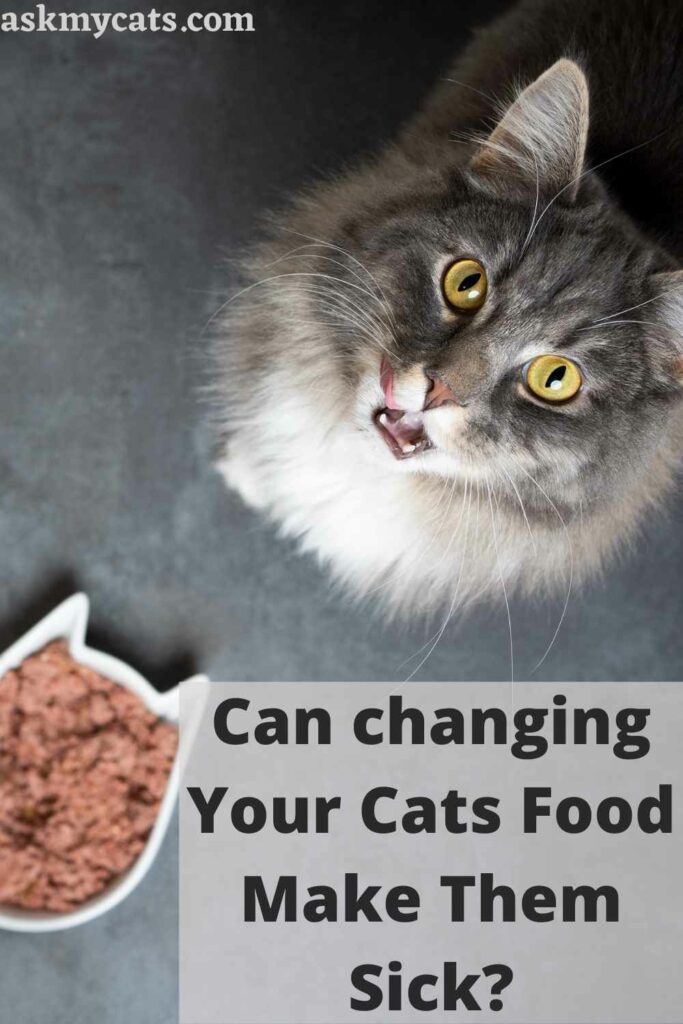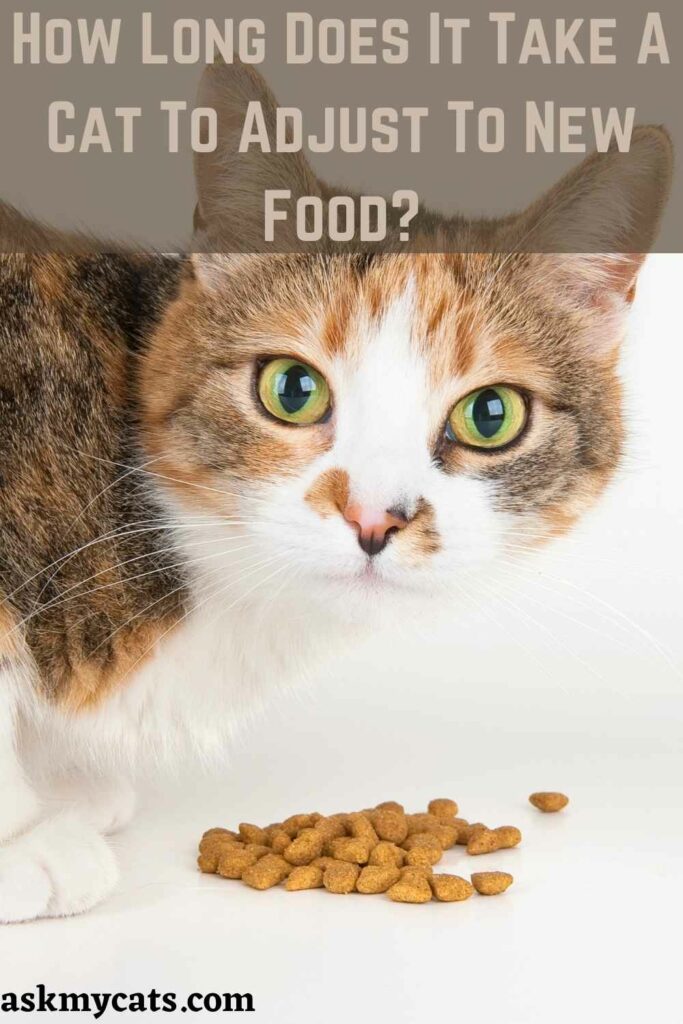There are a variety of reasons why you might want or need to switch your cat’s food. Your cat may have developed a medical condition that necessitates the use of a particular diet. It’s possible that the food your cat has been eating is no longer available. Alternatively, you might just switch your cat to a higher-quality diet.
So, is switching cat food safe?
Yes, switching cat food is safe and needed for cats as cats’ nutritional requirements change as they become older. Take protein, for example, kittens require a lot of it, whereas adult cats require less. Too much protein can affect the liver and kidneys in older cats.
This article will talk about how you can change your cat’s food and should you do it.


Give Your Cat the Perfect Day
Get the Free Ebook!
Is It OK To Keep Changing Cat Food?
No, it is not ok to keep changing your cat food as cats are creatures of habit.
You may wish to switch your cat’s food to a different brand or variety, either because you prefer it or because you’ve been instructed to do so for a medical reason, such as a renal disease special diet.
It’s always ideal to introduce new foods gradually over several weeks. Although this may appear to be a lengthy time, it is better to be patient in order to avoid any issues.
This is especially true for cats, which are creatures of habit and are sometimes hesitant to adapt to a new meal right away. If you rush through the process, your cat may refuse to consume the food you offer, forcing you to find another solution.
Never abruptly modify their food unless your veterinarian advises you to. This is because abrupt dietary changes can induce stomach irritation or even diarrhea in certain pets, making them less likely to accept the food that is presented to them.
Can Changing Your Cats Food Make Them Sick?
Yes, changing your cat’s food could make it sick if it is done abruptly.

Kittens become accustomed to eating a specific sort of cat food, potentially even a specific brand.
While you may be concerned that your cat would become bored eating the same sort of food every day, he seems unconcerned.
He’s used to what he’s used to, and that’s it.
You’ll pay if you try to turn him from dry to wet! (At least in his head.)
If you try to switch from one brand to another, he might be able to pick up on the little differences in flavor.
It’s tough, but not impossible, to persuade him to change. Simply replenish your patience reserves.
You’re going to need every ounce of that virtue.
Changing your cat’s diet too quickly might induce changes in the gut flora (bacteria and other microbes), which can lead to diarrhea and vomiting.
It is the sudden change and the cat’s body’s lack of acclimatization to the new diet that causes the problem in this scenario, not the food itself.
Begin by combining a small bit of the new food with the old. Gradually increase the percentages over several days until you’re feeding virtually entirely new food, then make the final move.
For example, on the first day, you might feed 90% original meal and 10% new food. The cuisine on the second day could be 80 percent original and 20% new. It’s best to do this for three to four days, or even longer if required.
Reduce the percentage of new food and check your cat’s health if they show signs of stomach trouble or food aversion during this time.
How Long Does It Take A Cat To Adjust To New Food?
It will usually take 1-2 weeks for a cat to adjust to its new food.

If at all feasible, your cat should be moved from one food to another gradually.
Sudden dietary changes in your cat can cause gastrointestinal discomfort, resulting in diarrhea, vomiting, and even a loss of appetite.
Ideally, you should plan on transitioning your cat from one food to another for at least a week.
Start by mixing in a little bit of the new food with the old if your cat isn’t picky.
Each day, gradually increase the amount of fresh food while decreasing the amount of old food by a similar amount.
Check to see if your cat is consuming the food. If all goes well, at the end of the week, you should only be feeding the new food.
Many cats, however, are finicky about what they eat. It can be tough to shift some cats who have become accustomed to a specific type of diet.
It is typically feasible to persuade these cats to try a new food, but it takes time and perseverance.
Never try to force your cat to consume a new diet by starving him. Cats who do not feed on a regular basis may acquire hepatic lipidosis, a potentially fatal illness.
You should be concerned if your cat goes more than 24 hours without eating. Cats who eat minimal amounts of food may take longer to become ill, although hepatic lipidosis can develop in as little as a few days.
If your cat is picky and won’t accept the new food, you’ll need to start with planned meals rather than free-choice feeding.
You should feed your cat two to three times a day, with any uneaten food removed within 20-30 minutes. Begin this approach while continuing to eat the old diet.
Once your cat has established a regular feeding schedule, try blending a little amount of the new food with the old. Offer your cat no more food in one meal than he would typically consume in the 20-30 minutes that the food is available.
Hopefully, your cat will be interested enough in the new mixture to accept it. If you’re having success, gradually increase the amount of new food while decreasing the amount of old food each day.
Take it easy on the transition. Depending on your cat, this process could take much longer than a week. Your cat may reject the new mixture if you go too rapidly (i.e., give more new food and less old food).
If you need to feed the same combination of foods for several days before increasing the quantity of the new food, go ahead and do so.
Is It Normal For A Cat To Have Diarrhea After Changing Food?
Yes, it is normal for a cat to have to have diarrhea after changing food.

Any changes to your cat’s diet, especially if they’ve been eating the same food for a long time, might cause diarrhea and vomiting.
If your cat’s diarrhea is caused by a recent food change, try switching back to their old food to see if they improve.
Certain types of food might irritate cats’ stomachs, and other substances may cause them to vomit.
Raw cat food, a BARF diet, or a high-fiber diet are all examples of diets that may cause diarrhea in your cat.
Cow’s milk can also make cats sick, causing diarrhea in some circumstances.
A cat’s stomach can be upset even when switching from dry to wet food or vice versa.
Before you decide to change your cat’s diet, do some research on different brands and types. Meats like turkey and chicken, in general, are easier to digest, especially when served with rice or wheat.
If your cat has been suffering from diarrhea for a long time, it’s possible that it’s not due to their food.
There could be an underlying health concern if your cat has diarrhea and also exhibits any of the following symptoms:
- Has stopped eating and/or drinking
- Vomiting
- Lethargy
- Watery diarrhea
- Frequent diarrhea
- Diarrhea has blood in it
Cats can also acquire diarrhea if they have worms, absorb poisons, or are agitated, so if you’re worried about your cat, schedule an appointment with your veterinarian right away.
How Do I Know If I Need To Change My Cats Food?
The reasons behind the need to change cat’s food are: –
1. Life Stage
One of the most important reasons to switch your cat’s food is that they have reached a new life stage. Most pet food companies cater to specific age groups, such as kittens, adult cats, and seniors.
These foods may be fortified with specific nutrients; for example, kitten food has additional protein to aid in growth, while senior food may have unique nutrients to aid in the treatment of age-related ailments.
When your cat reaches a new life stage (from kitten to adult, and then from adult to senior), you should switch to a new type of food that is best suited to their age.
Consult your veterinarian to determine the appropriate diet for your pet’s unique requirements.
2. Allergies
Cats can acquire food allergies that are triggered by specific cat food ingredients, despite the fact that they aren’t particularly common. Your cat may be sensitive or allergic to their food if they get itchy, irritated skin, vomiting, or diarrhea.
Because a wide range of components can cause feline food allergies, you’ll want to collaborate with your veterinarian to identify the precise allergen using an elimination diet. Your cat will need to be put on a whole new diet throughout this procedure.
3. Specific Health Conditions
If your cat develops a health condition during its lifetime, there may be a meal that is more suited to its medical requirements.
Weight-management foods for obese cats to foods supplemented with urinary-health elements to help with urinary tract problems are all examples of these types of foods.
Other carefully prepared foods may help relieve arthritic pain, increase fiber for better digestion, and more.
Similarly, if your cat’s current food does not appear to be providing its nutritional demands, you might consider switching to a portion of higher-quality cat food with superior ingredients and more nutrients.
Regardless matter why you’re switching your cat’s diet, you should always visit your cat’s veterinarian first to ensure the new food is suitable for your cat’s age and health.
Your veterinarian should be able to answer questions and point you in the proper way if you need new pet food choices.
Frequently Asked Questions
How to transition from dry to wet cat food?
It might be particularly difficult to transition a cat from dry to wet food. The two types of food have quite distinct tastes and textures, and many cats will find their new meal weird. You might attempt a few tactics to make the shift smoother and the food more appealing. Until your cat is habituated to the smell of the wet food underneath, sprinkle the kibbles on top of it. Then you can try combining the dry and moist foods. To enhance taste and make the food more appetizing, grind some of the dry food into a powder and mix it in with the wet food.
At what life stages should I change my cat’s diet?
Kittens should be switched to adult cat food at the age of 12 months to ensure they are getting the right nutrients. Cats who are 7 years or older should also switch to a mature adult or senior cat food, which guarantees that they are getting the right amount of nutrients for their age. Cats that are pregnant or nursing require high-energy, high-calcium meals. During this important time, make sure they’re eating kitten food.
Should I add digestive supplements to my cat’s new diet?
Digestive supplements, such as prebiotics and digestive enzymes, can help your cat adjust to a new diet. Although they are rarely required–a slow food transition should address most digestive system issues–they almost always improve your cat’s digestion.
Final Words
Keep a close eye on your cat’s behavior once they’ve fully adjusted to their new food. This will assist you in determining how well they are adapting to the change – the best diets will be visible in your cat’s appearance, body weight, and stool quality.
If you have any unanswered questions, feel free to ask us in the comments sections.
